Critical Evaluation of AOD and Mental Health Programs and Services
VerifiedAdded on 2022/09/06
|10
|2280
|23
Report
AI Summary
This report critically evaluates the programs and services offered by Salvation Foster House for individuals experiencing co-occurring alcohol and other drug (AOD) use and mental health disorders. It begins with an introduction to the prevalence of AOD use in Australia and its link to mental health issues. The report outlines several evidence-based models for addressing addiction and mental health, including the moral, disease, learning and behavioral, socio-cultural, and psychodynamic models, as well as the cognitive behavioral and biological/genetic theories. It then focuses on the socio-cultural model, which is used by Salvation Foster House. The report describes the presenting issues of the chosen client group (those affected by poverty and related issues), eligibility criteria for services, and the AOD programs available, such as the National Disability Insurance Scheme (NDIS), Mental Health Community Living Supports for refugees, Family Mental Health Support Service, and Anglicare Art Space. Finally, the report explores the interagency case management process based on the socio-cultural model, including steps such as assessment, planning, implementation, and review, concluding with an overview of the findings and recommendations. The report utilizes scholarly sources to support its claims and findings.
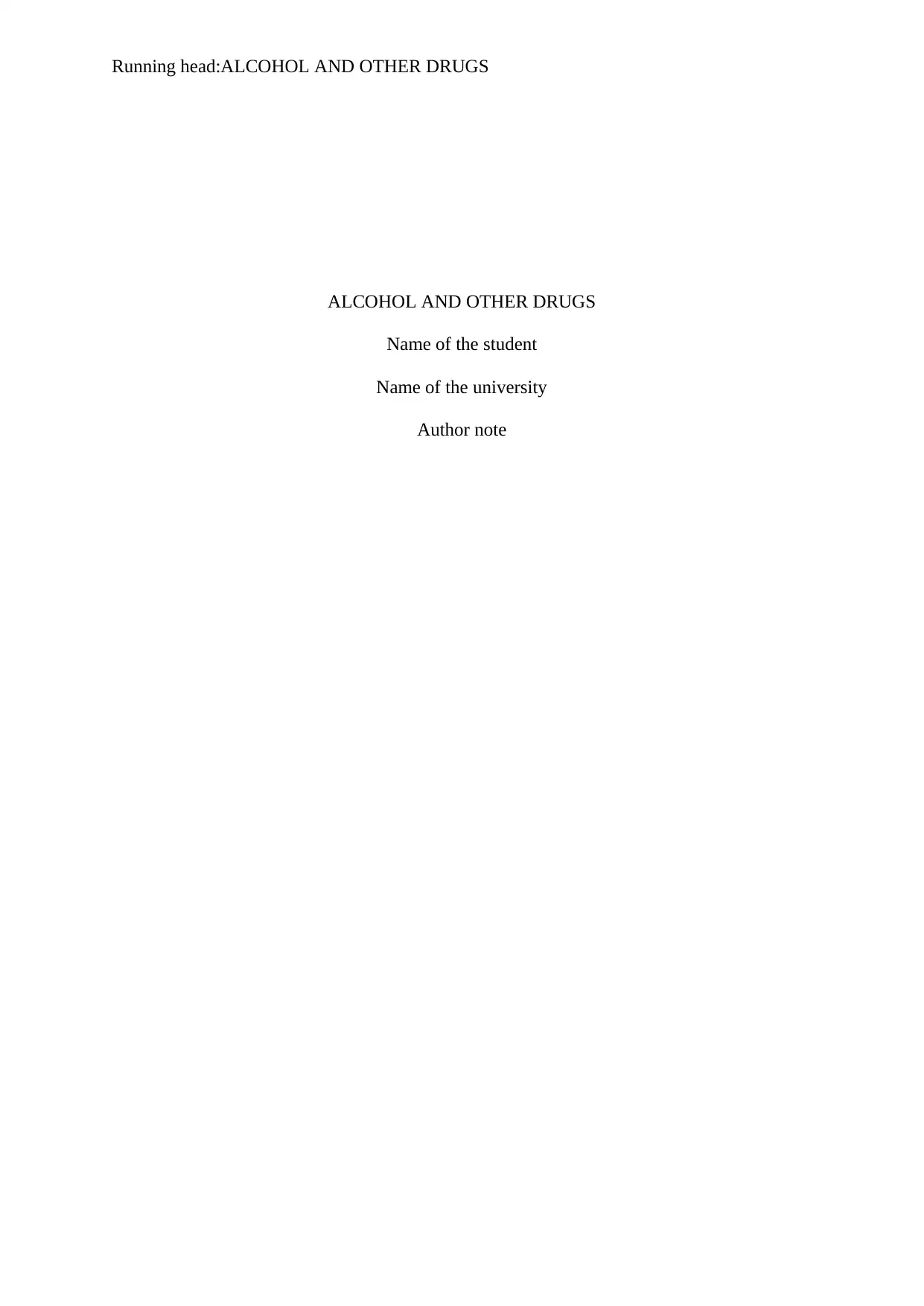
Running head:ALCOHOL AND OTHER DRUGS
ALCOHOL AND OTHER DRUGS
Name of the student
Name of the university
Author note
ALCOHOL AND OTHER DRUGS
Name of the student
Name of the university
Author note
Paraphrase This Document
Need a fresh take? Get an instant paraphrase of this document with our AI Paraphraser
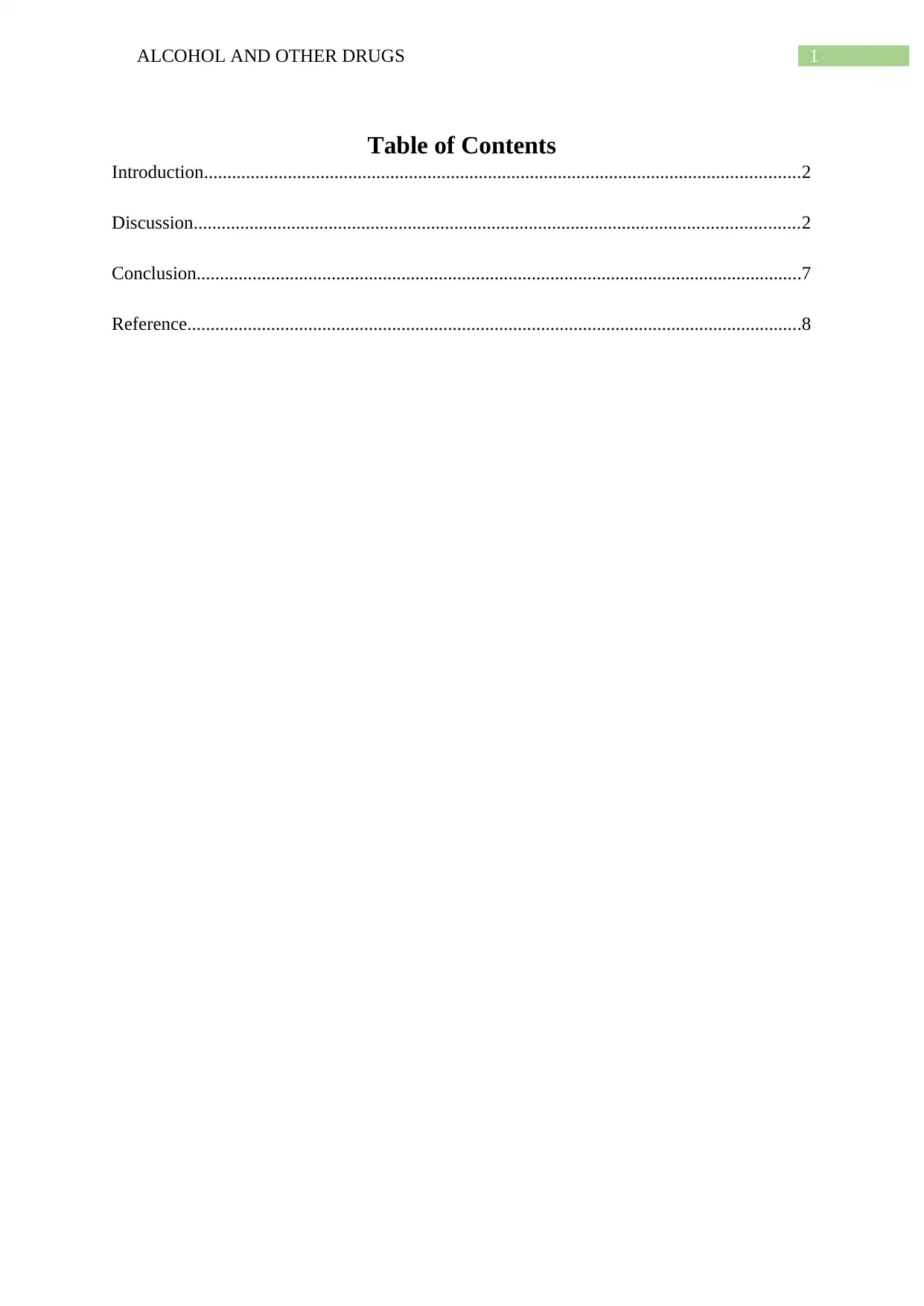
1ALCOHOL AND OTHER DRUGS
Table of Contents
Introduction................................................................................................................................2
Discussion..................................................................................................................................2
Conclusion..................................................................................................................................7
Reference....................................................................................................................................8
Table of Contents
Introduction................................................................................................................................2
Discussion..................................................................................................................................2
Conclusion..................................................................................................................................7
Reference....................................................................................................................................8
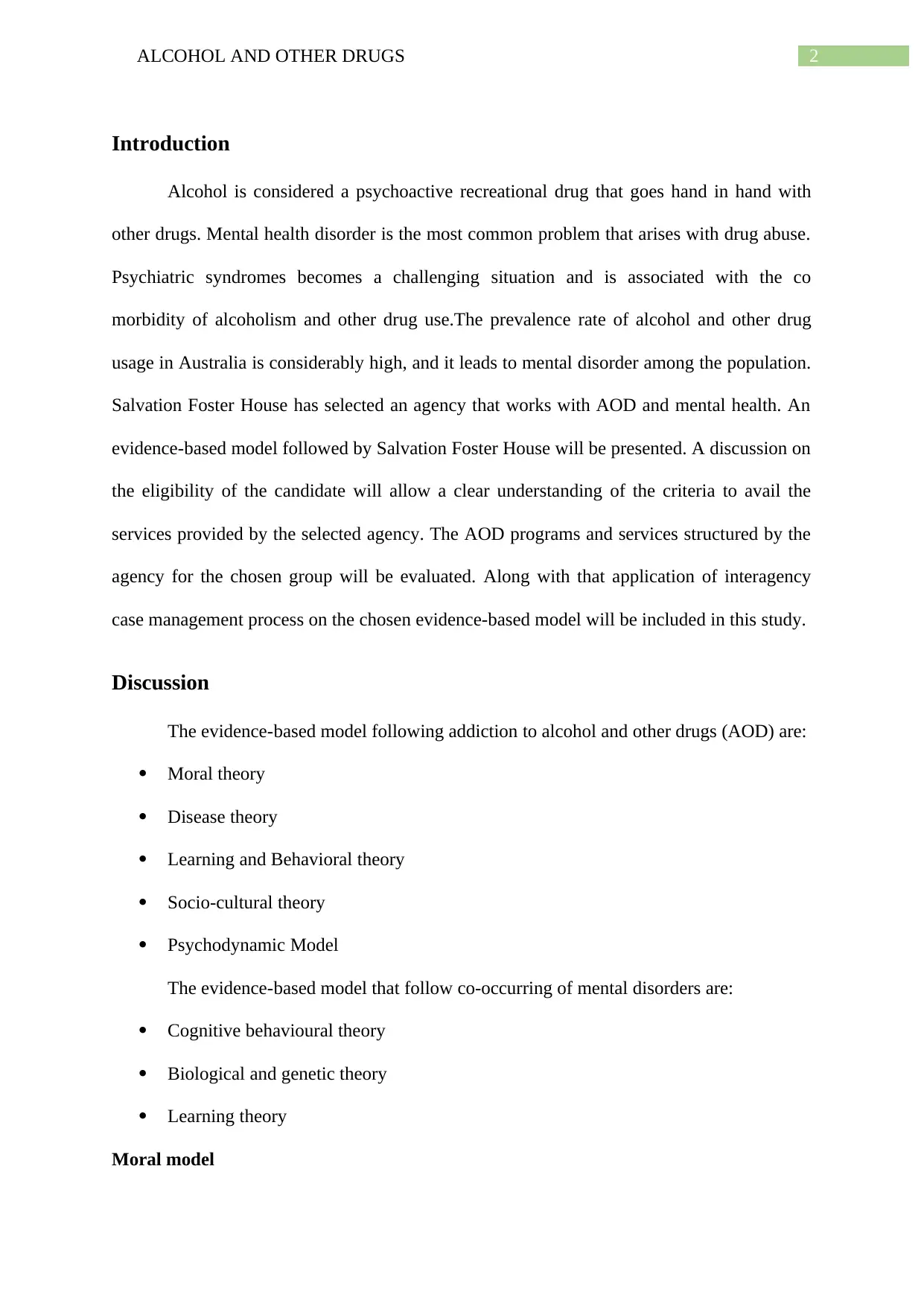
2ALCOHOL AND OTHER DRUGS
Introduction
Alcohol is considered a psychoactive recreational drug that goes hand in hand with
other drugs. Mental health disorder is the most common problem that arises with drug abuse.
Psychiatric syndromes becomes a challenging situation and is associated with the co
morbidity of alcoholism and other drug use.The prevalence rate of alcohol and other drug
usage in Australia is considerably high, and it leads to mental disorder among the population.
Salvation Foster House has selected an agency that works with AOD and mental health. An
evidence-based model followed by Salvation Foster House will be presented. A discussion on
the eligibility of the candidate will allow a clear understanding of the criteria to avail the
services provided by the selected agency. The AOD programs and services structured by the
agency for the chosen group will be evaluated. Along with that application of interagency
case management process on the chosen evidence-based model will be included in this study.
Discussion
The evidence-based model following addiction to alcohol and other drugs (AOD) are:
Moral theory
Disease theory
Learning and Behavioral theory
Socio-cultural theory
Psychodynamic Model
The evidence-based model that follow co-occurring of mental disorders are:
Cognitive behavioural theory
Biological and genetic theory
Learning theory
Moral model
Introduction
Alcohol is considered a psychoactive recreational drug that goes hand in hand with
other drugs. Mental health disorder is the most common problem that arises with drug abuse.
Psychiatric syndromes becomes a challenging situation and is associated with the co
morbidity of alcoholism and other drug use.The prevalence rate of alcohol and other drug
usage in Australia is considerably high, and it leads to mental disorder among the population.
Salvation Foster House has selected an agency that works with AOD and mental health. An
evidence-based model followed by Salvation Foster House will be presented. A discussion on
the eligibility of the candidate will allow a clear understanding of the criteria to avail the
services provided by the selected agency. The AOD programs and services structured by the
agency for the chosen group will be evaluated. Along with that application of interagency
case management process on the chosen evidence-based model will be included in this study.
Discussion
The evidence-based model following addiction to alcohol and other drugs (AOD) are:
Moral theory
Disease theory
Learning and Behavioral theory
Socio-cultural theory
Psychodynamic Model
The evidence-based model that follow co-occurring of mental disorders are:
Cognitive behavioural theory
Biological and genetic theory
Learning theory
Moral model
⊘ This is a preview!⊘
Do you want full access?
Subscribe today to unlock all pages.

Trusted by 1+ million students worldwide
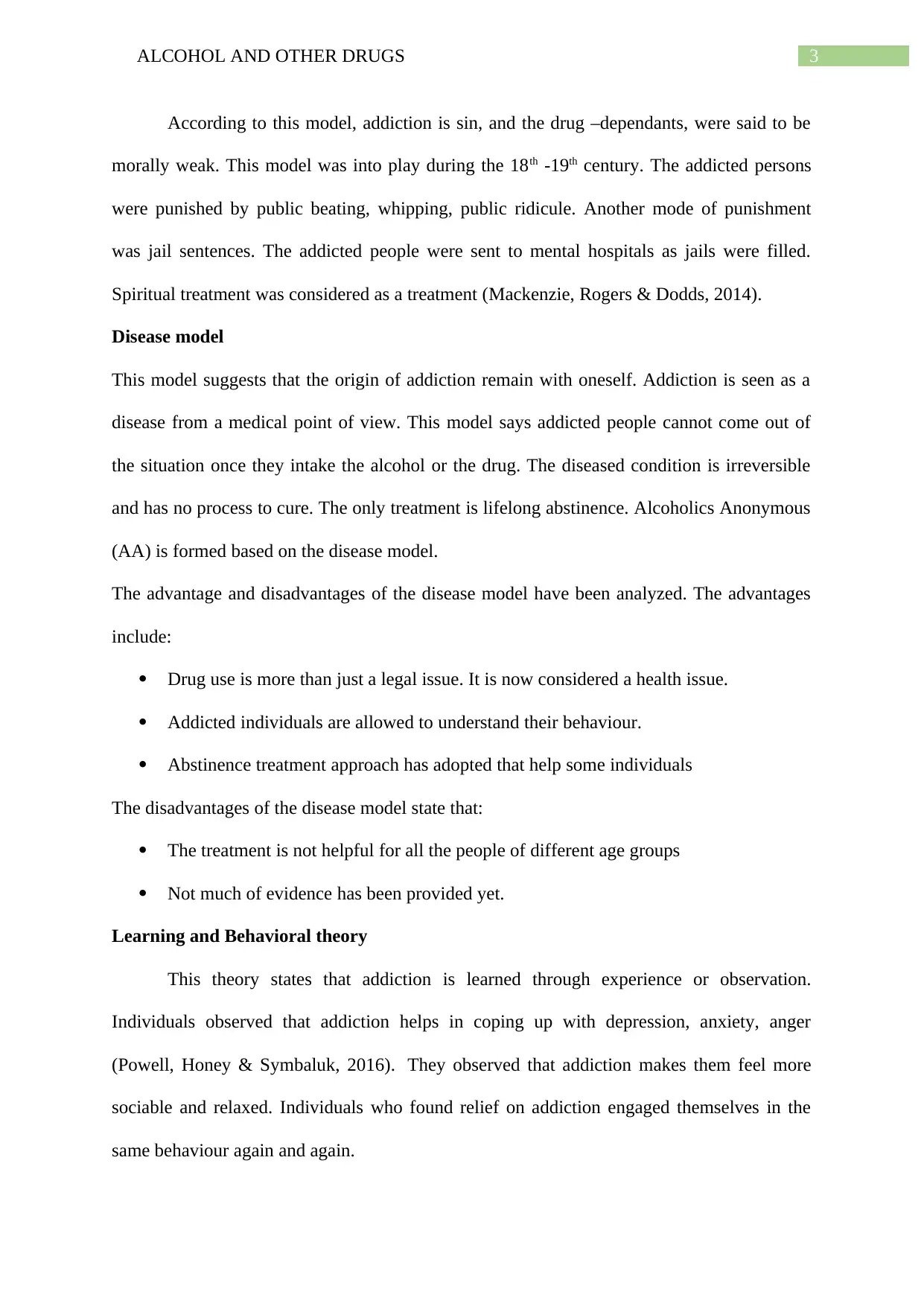
3ALCOHOL AND OTHER DRUGS
According to this model, addiction is sin, and the drug –dependants, were said to be
morally weak. This model was into play during the 18th -19th century. The addicted persons
were punished by public beating, whipping, public ridicule. Another mode of punishment
was jail sentences. The addicted people were sent to mental hospitals as jails were filled.
Spiritual treatment was considered as a treatment (Mackenzie, Rogers & Dodds, 2014).
Disease model
This model suggests that the origin of addiction remain with oneself. Addiction is seen as a
disease from a medical point of view. This model says addicted people cannot come out of
the situation once they intake the alcohol or the drug. The diseased condition is irreversible
and has no process to cure. The only treatment is lifelong abstinence. Alcoholics Anonymous
(AA) is formed based on the disease model.
The advantage and disadvantages of the disease model have been analyzed. The advantages
include:
Drug use is more than just a legal issue. It is now considered a health issue.
Addicted individuals are allowed to understand their behaviour.
Abstinence treatment approach has adopted that help some individuals
The disadvantages of the disease model state that:
The treatment is not helpful for all the people of different age groups
Not much of evidence has been provided yet.
Learning and Behavioral theory
This theory states that addiction is learned through experience or observation.
Individuals observed that addiction helps in coping up with depression, anxiety, anger
(Powell, Honey & Symbaluk, 2016). They observed that addiction makes them feel more
sociable and relaxed. Individuals who found relief on addiction engaged themselves in the
same behaviour again and again.
According to this model, addiction is sin, and the drug –dependants, were said to be
morally weak. This model was into play during the 18th -19th century. The addicted persons
were punished by public beating, whipping, public ridicule. Another mode of punishment
was jail sentences. The addicted people were sent to mental hospitals as jails were filled.
Spiritual treatment was considered as a treatment (Mackenzie, Rogers & Dodds, 2014).
Disease model
This model suggests that the origin of addiction remain with oneself. Addiction is seen as a
disease from a medical point of view. This model says addicted people cannot come out of
the situation once they intake the alcohol or the drug. The diseased condition is irreversible
and has no process to cure. The only treatment is lifelong abstinence. Alcoholics Anonymous
(AA) is formed based on the disease model.
The advantage and disadvantages of the disease model have been analyzed. The advantages
include:
Drug use is more than just a legal issue. It is now considered a health issue.
Addicted individuals are allowed to understand their behaviour.
Abstinence treatment approach has adopted that help some individuals
The disadvantages of the disease model state that:
The treatment is not helpful for all the people of different age groups
Not much of evidence has been provided yet.
Learning and Behavioral theory
This theory states that addiction is learned through experience or observation.
Individuals observed that addiction helps in coping up with depression, anxiety, anger
(Powell, Honey & Symbaluk, 2016). They observed that addiction makes them feel more
sociable and relaxed. Individuals who found relief on addiction engaged themselves in the
same behaviour again and again.
Paraphrase This Document
Need a fresh take? Get an instant paraphrase of this document with our AI Paraphraser
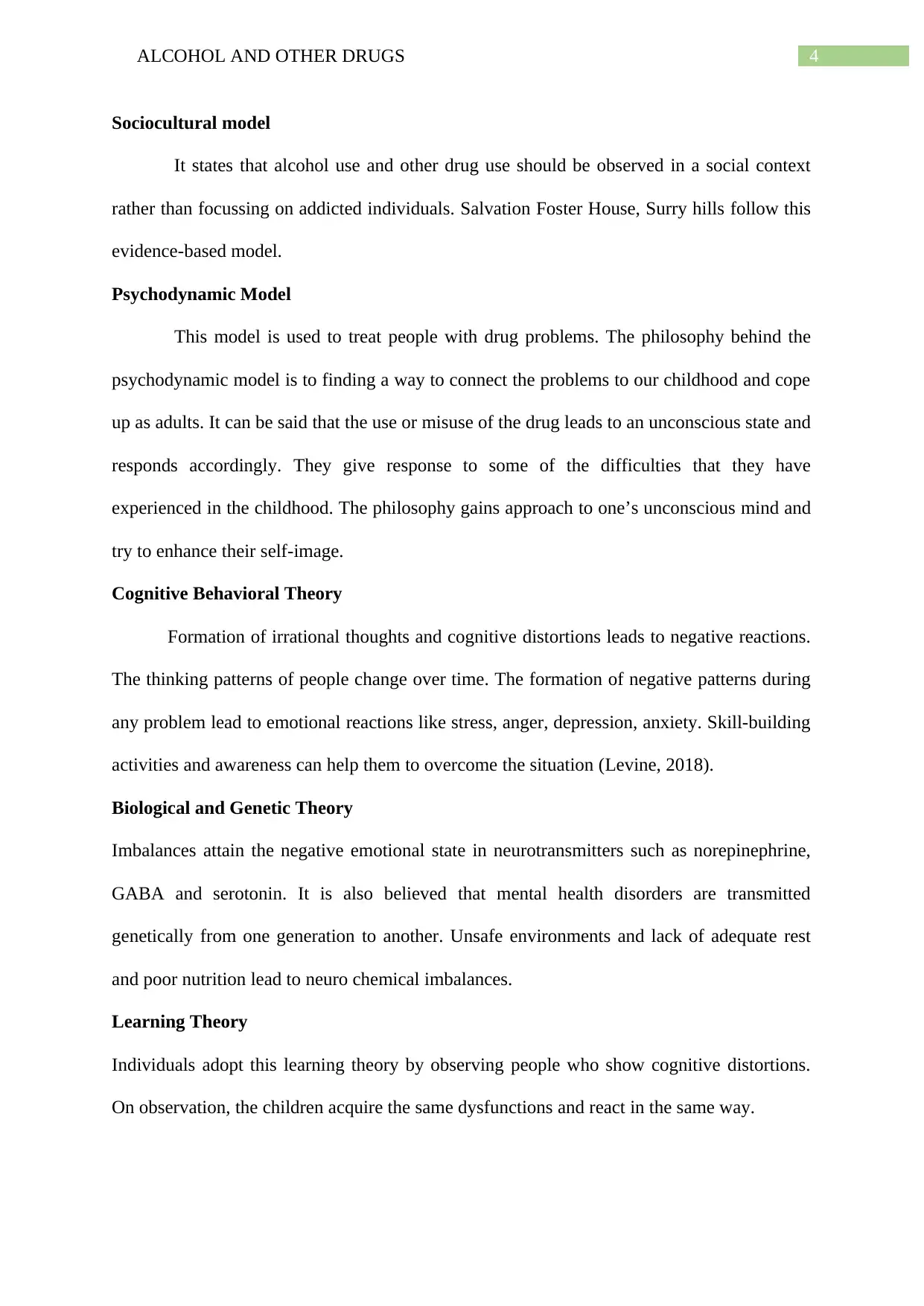
4ALCOHOL AND OTHER DRUGS
Sociocultural model
It states that alcohol use and other drug use should be observed in a social context
rather than focussing on addicted individuals. Salvation Foster House, Surry hills follow this
evidence-based model.
Psychodynamic Model
This model is used to treat people with drug problems. The philosophy behind the
psychodynamic model is to finding a way to connect the problems to our childhood and cope
up as adults. It can be said that the use or misuse of the drug leads to an unconscious state and
responds accordingly. They give response to some of the difficulties that they have
experienced in the childhood. The philosophy gains approach to one’s unconscious mind and
try to enhance their self-image.
Cognitive Behavioral Theory
Formation of irrational thoughts and cognitive distortions leads to negative reactions.
The thinking patterns of people change over time. The formation of negative patterns during
any problem lead to emotional reactions like stress, anger, depression, anxiety. Skill-building
activities and awareness can help them to overcome the situation (Levine, 2018).
Biological and Genetic Theory
Imbalances attain the negative emotional state in neurotransmitters such as norepinephrine,
GABA and serotonin. It is also believed that mental health disorders are transmitted
genetically from one generation to another. Unsafe environments and lack of adequate rest
and poor nutrition lead to neuro chemical imbalances.
Learning Theory
Individuals adopt this learning theory by observing people who show cognitive distortions.
On observation, the children acquire the same dysfunctions and react in the same way.
Sociocultural model
It states that alcohol use and other drug use should be observed in a social context
rather than focussing on addicted individuals. Salvation Foster House, Surry hills follow this
evidence-based model.
Psychodynamic Model
This model is used to treat people with drug problems. The philosophy behind the
psychodynamic model is to finding a way to connect the problems to our childhood and cope
up as adults. It can be said that the use or misuse of the drug leads to an unconscious state and
responds accordingly. They give response to some of the difficulties that they have
experienced in the childhood. The philosophy gains approach to one’s unconscious mind and
try to enhance their self-image.
Cognitive Behavioral Theory
Formation of irrational thoughts and cognitive distortions leads to negative reactions.
The thinking patterns of people change over time. The formation of negative patterns during
any problem lead to emotional reactions like stress, anger, depression, anxiety. Skill-building
activities and awareness can help them to overcome the situation (Levine, 2018).
Biological and Genetic Theory
Imbalances attain the negative emotional state in neurotransmitters such as norepinephrine,
GABA and serotonin. It is also believed that mental health disorders are transmitted
genetically from one generation to another. Unsafe environments and lack of adequate rest
and poor nutrition lead to neuro chemical imbalances.
Learning Theory
Individuals adopt this learning theory by observing people who show cognitive distortions.
On observation, the children acquire the same dysfunctions and react in the same way.
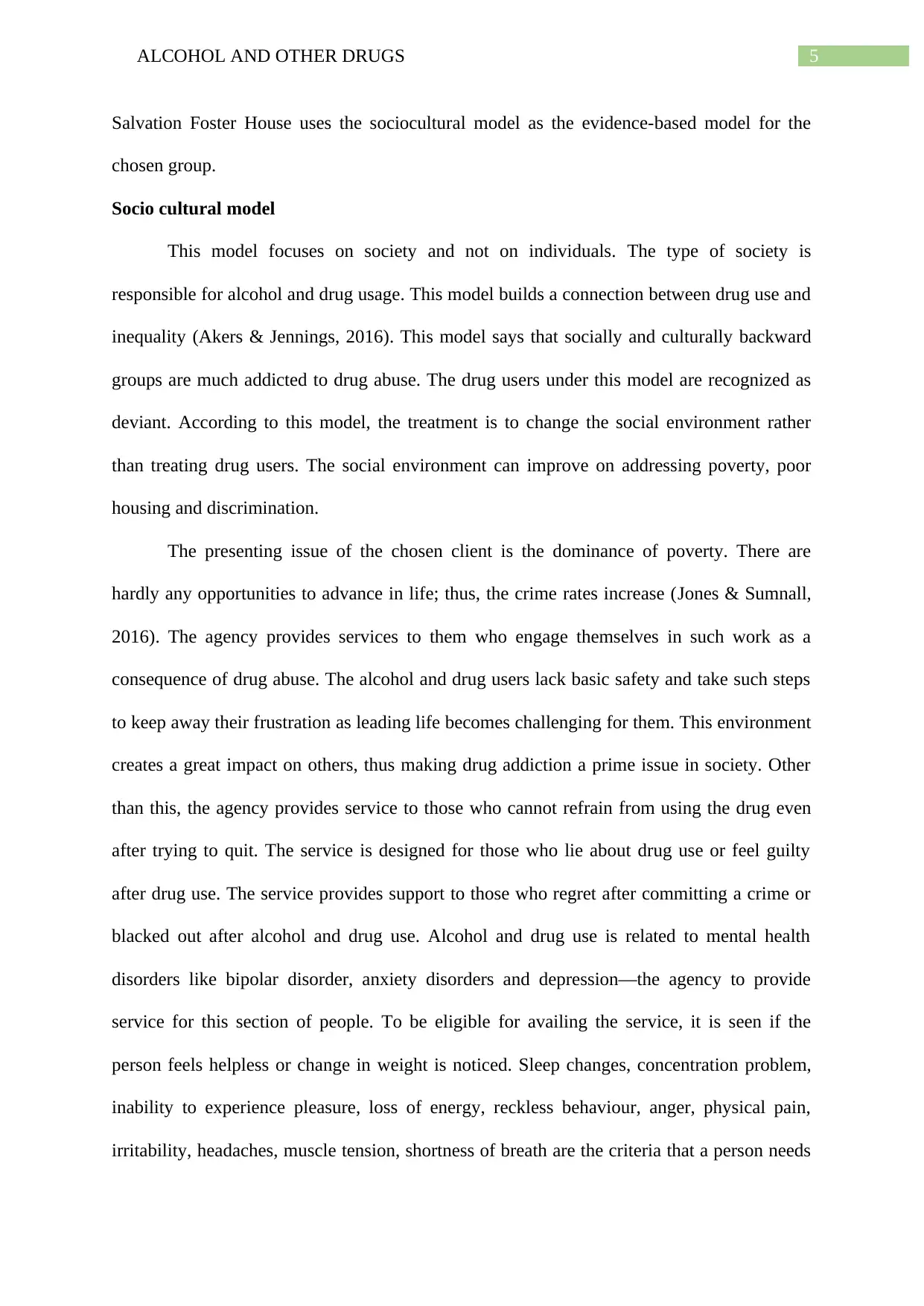
5ALCOHOL AND OTHER DRUGS
Salvation Foster House uses the sociocultural model as the evidence-based model for the
chosen group.
Socio cultural model
This model focuses on society and not on individuals. The type of society is
responsible for alcohol and drug usage. This model builds a connection between drug use and
inequality (Akers & Jennings, 2016). This model says that socially and culturally backward
groups are much addicted to drug abuse. The drug users under this model are recognized as
deviant. According to this model, the treatment is to change the social environment rather
than treating drug users. The social environment can improve on addressing poverty, poor
housing and discrimination.
The presenting issue of the chosen client is the dominance of poverty. There are
hardly any opportunities to advance in life; thus, the crime rates increase (Jones & Sumnall,
2016). The agency provides services to them who engage themselves in such work as a
consequence of drug abuse. The alcohol and drug users lack basic safety and take such steps
to keep away their frustration as leading life becomes challenging for them. This environment
creates a great impact on others, thus making drug addiction a prime issue in society. Other
than this, the agency provides service to those who cannot refrain from using the drug even
after trying to quit. The service is designed for those who lie about drug use or feel guilty
after drug use. The service provides support to those who regret after committing a crime or
blacked out after alcohol and drug use. Alcohol and drug use is related to mental health
disorders like bipolar disorder, anxiety disorders and depression—the agency to provide
service for this section of people. To be eligible for availing the service, it is seen if the
person feels helpless or change in weight is noticed. Sleep changes, concentration problem,
inability to experience pleasure, loss of energy, reckless behaviour, anger, physical pain,
irritability, headaches, muscle tension, shortness of breath are the criteria that a person needs
Salvation Foster House uses the sociocultural model as the evidence-based model for the
chosen group.
Socio cultural model
This model focuses on society and not on individuals. The type of society is
responsible for alcohol and drug usage. This model builds a connection between drug use and
inequality (Akers & Jennings, 2016). This model says that socially and culturally backward
groups are much addicted to drug abuse. The drug users under this model are recognized as
deviant. According to this model, the treatment is to change the social environment rather
than treating drug users. The social environment can improve on addressing poverty, poor
housing and discrimination.
The presenting issue of the chosen client is the dominance of poverty. There are
hardly any opportunities to advance in life; thus, the crime rates increase (Jones & Sumnall,
2016). The agency provides services to them who engage themselves in such work as a
consequence of drug abuse. The alcohol and drug users lack basic safety and take such steps
to keep away their frustration as leading life becomes challenging for them. This environment
creates a great impact on others, thus making drug addiction a prime issue in society. Other
than this, the agency provides service to those who cannot refrain from using the drug even
after trying to quit. The service is designed for those who lie about drug use or feel guilty
after drug use. The service provides support to those who regret after committing a crime or
blacked out after alcohol and drug use. Alcohol and drug use is related to mental health
disorders like bipolar disorder, anxiety disorders and depression—the agency to provide
service for this section of people. To be eligible for availing the service, it is seen if the
person feels helpless or change in weight is noticed. Sleep changes, concentration problem,
inability to experience pleasure, loss of energy, reckless behaviour, anger, physical pain,
irritability, headaches, muscle tension, shortness of breath are the criteria that a person needs
⊘ This is a preview!⊘
Do you want full access?
Subscribe today to unlock all pages.

Trusted by 1+ million students worldwide
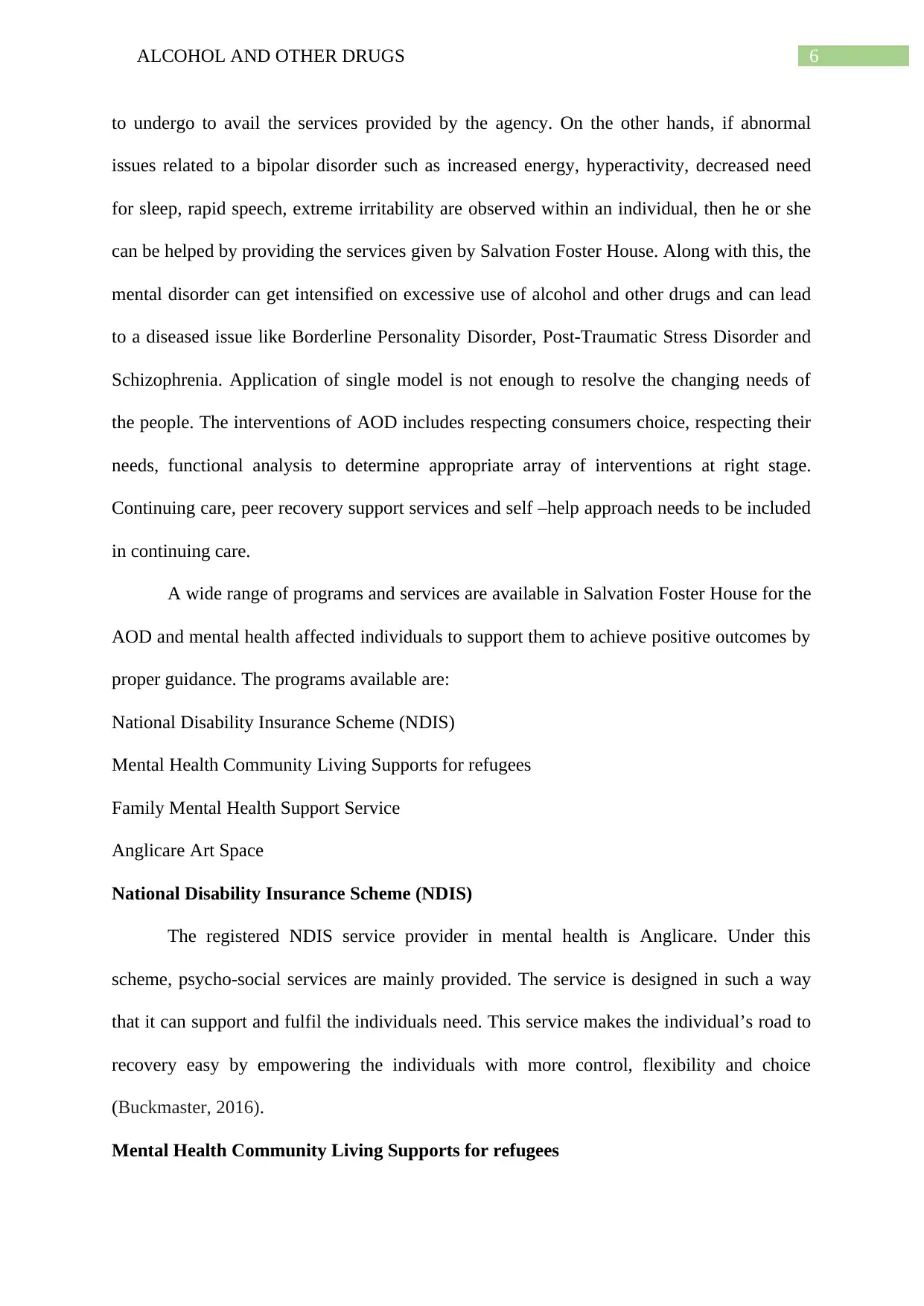
6ALCOHOL AND OTHER DRUGS
to undergo to avail the services provided by the agency. On the other hands, if abnormal
issues related to a bipolar disorder such as increased energy, hyperactivity, decreased need
for sleep, rapid speech, extreme irritability are observed within an individual, then he or she
can be helped by providing the services given by Salvation Foster House. Along with this, the
mental disorder can get intensified on excessive use of alcohol and other drugs and can lead
to a diseased issue like Borderline Personality Disorder, Post-Traumatic Stress Disorder and
Schizophrenia. Application of single model is not enough to resolve the changing needs of
the people. The interventions of AOD includes respecting consumers choice, respecting their
needs, functional analysis to determine appropriate array of interventions at right stage.
Continuing care, peer recovery support services and self –help approach needs to be included
in continuing care.
A wide range of programs and services are available in Salvation Foster House for the
AOD and mental health affected individuals to support them to achieve positive outcomes by
proper guidance. The programs available are:
National Disability Insurance Scheme (NDIS)
Mental Health Community Living Supports for refugees
Family Mental Health Support Service
Anglicare Art Space
National Disability Insurance Scheme (NDIS)
The registered NDIS service provider in mental health is Anglicare. Under this
scheme, psycho-social services are mainly provided. The service is designed in such a way
that it can support and fulfil the individuals need. This service makes the individual’s road to
recovery easy by empowering the individuals with more control, flexibility and choice
(Buckmaster, 2016).
Mental Health Community Living Supports for refugees
to undergo to avail the services provided by the agency. On the other hands, if abnormal
issues related to a bipolar disorder such as increased energy, hyperactivity, decreased need
for sleep, rapid speech, extreme irritability are observed within an individual, then he or she
can be helped by providing the services given by Salvation Foster House. Along with this, the
mental disorder can get intensified on excessive use of alcohol and other drugs and can lead
to a diseased issue like Borderline Personality Disorder, Post-Traumatic Stress Disorder and
Schizophrenia. Application of single model is not enough to resolve the changing needs of
the people. The interventions of AOD includes respecting consumers choice, respecting their
needs, functional analysis to determine appropriate array of interventions at right stage.
Continuing care, peer recovery support services and self –help approach needs to be included
in continuing care.
A wide range of programs and services are available in Salvation Foster House for the
AOD and mental health affected individuals to support them to achieve positive outcomes by
proper guidance. The programs available are:
National Disability Insurance Scheme (NDIS)
Mental Health Community Living Supports for refugees
Family Mental Health Support Service
Anglicare Art Space
National Disability Insurance Scheme (NDIS)
The registered NDIS service provider in mental health is Anglicare. Under this
scheme, psycho-social services are mainly provided. The service is designed in such a way
that it can support and fulfil the individuals need. This service makes the individual’s road to
recovery easy by empowering the individuals with more control, flexibility and choice
(Buckmaster, 2016).
Mental Health Community Living Supports for refugees
Paraphrase This Document
Need a fresh take? Get an instant paraphrase of this document with our AI Paraphraser
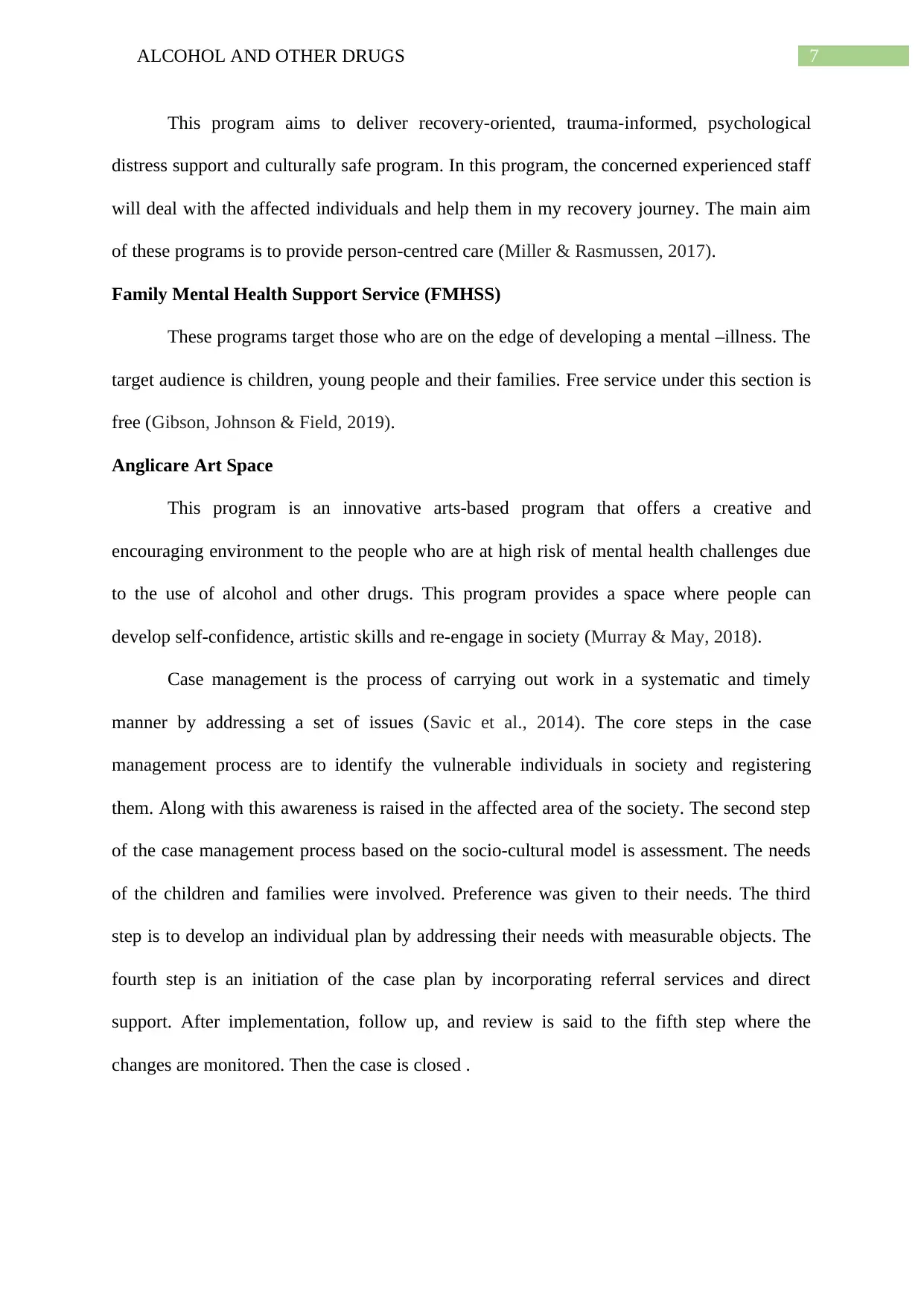
7ALCOHOL AND OTHER DRUGS
This program aims to deliver recovery-oriented, trauma-informed, psychological
distress support and culturally safe program. In this program, the concerned experienced staff
will deal with the affected individuals and help them in my recovery journey. The main aim
of these programs is to provide person-centred care (Miller & Rasmussen, 2017).
Family Mental Health Support Service (FMHSS)
These programs target those who are on the edge of developing a mental –illness. The
target audience is children, young people and their families. Free service under this section is
free (Gibson, Johnson & Field, 2019).
Anglicare Art Space
This program is an innovative arts-based program that offers a creative and
encouraging environment to the people who are at high risk of mental health challenges due
to the use of alcohol and other drugs. This program provides a space where people can
develop self-confidence, artistic skills and re-engage in society (Murray & May, 2018).
Case management is the process of carrying out work in a systematic and timely
manner by addressing a set of issues (Savic et al., 2014). The core steps in the case
management process are to identify the vulnerable individuals in society and registering
them. Along with this awareness is raised in the affected area of the society. The second step
of the case management process based on the socio-cultural model is assessment. The needs
of the children and families were involved. Preference was given to their needs. The third
step is to develop an individual plan by addressing their needs with measurable objects. The
fourth step is an initiation of the case plan by incorporating referral services and direct
support. After implementation, follow up, and review is said to the fifth step where the
changes are monitored. Then the case is closed .
This program aims to deliver recovery-oriented, trauma-informed, psychological
distress support and culturally safe program. In this program, the concerned experienced staff
will deal with the affected individuals and help them in my recovery journey. The main aim
of these programs is to provide person-centred care (Miller & Rasmussen, 2017).
Family Mental Health Support Service (FMHSS)
These programs target those who are on the edge of developing a mental –illness. The
target audience is children, young people and their families. Free service under this section is
free (Gibson, Johnson & Field, 2019).
Anglicare Art Space
This program is an innovative arts-based program that offers a creative and
encouraging environment to the people who are at high risk of mental health challenges due
to the use of alcohol and other drugs. This program provides a space where people can
develop self-confidence, artistic skills and re-engage in society (Murray & May, 2018).
Case management is the process of carrying out work in a systematic and timely
manner by addressing a set of issues (Savic et al., 2014). The core steps in the case
management process are to identify the vulnerable individuals in society and registering
them. Along with this awareness is raised in the affected area of the society. The second step
of the case management process based on the socio-cultural model is assessment. The needs
of the children and families were involved. Preference was given to their needs. The third
step is to develop an individual plan by addressing their needs with measurable objects. The
fourth step is an initiation of the case plan by incorporating referral services and direct
support. After implementation, follow up, and review is said to the fifth step where the
changes are monitored. Then the case is closed .
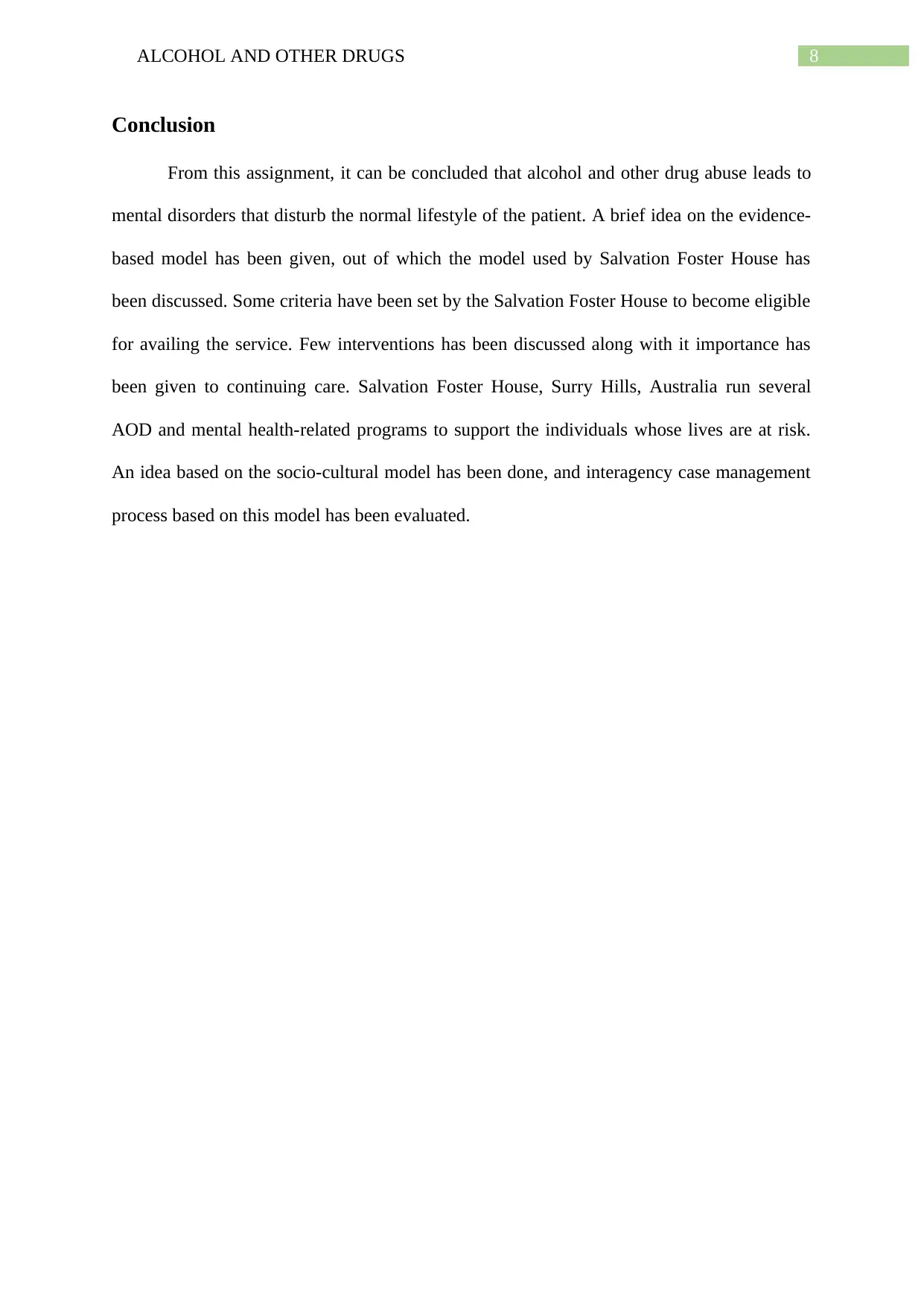
8ALCOHOL AND OTHER DRUGS
Conclusion
From this assignment, it can be concluded that alcohol and other drug abuse leads to
mental disorders that disturb the normal lifestyle of the patient. A brief idea on the evidence-
based model has been given, out of which the model used by Salvation Foster House has
been discussed. Some criteria have been set by the Salvation Foster House to become eligible
for availing the service. Few interventions has been discussed along with it importance has
been given to continuing care. Salvation Foster House, Surry Hills, Australia run several
AOD and mental health-related programs to support the individuals whose lives are at risk.
An idea based on the socio-cultural model has been done, and interagency case management
process based on this model has been evaluated.
Conclusion
From this assignment, it can be concluded that alcohol and other drug abuse leads to
mental disorders that disturb the normal lifestyle of the patient. A brief idea on the evidence-
based model has been given, out of which the model used by Salvation Foster House has
been discussed. Some criteria have been set by the Salvation Foster House to become eligible
for availing the service. Few interventions has been discussed along with it importance has
been given to continuing care. Salvation Foster House, Surry Hills, Australia run several
AOD and mental health-related programs to support the individuals whose lives are at risk.
An idea based on the socio-cultural model has been done, and interagency case management
process based on this model has been evaluated.
⊘ This is a preview!⊘
Do you want full access?
Subscribe today to unlock all pages.

Trusted by 1+ million students worldwide
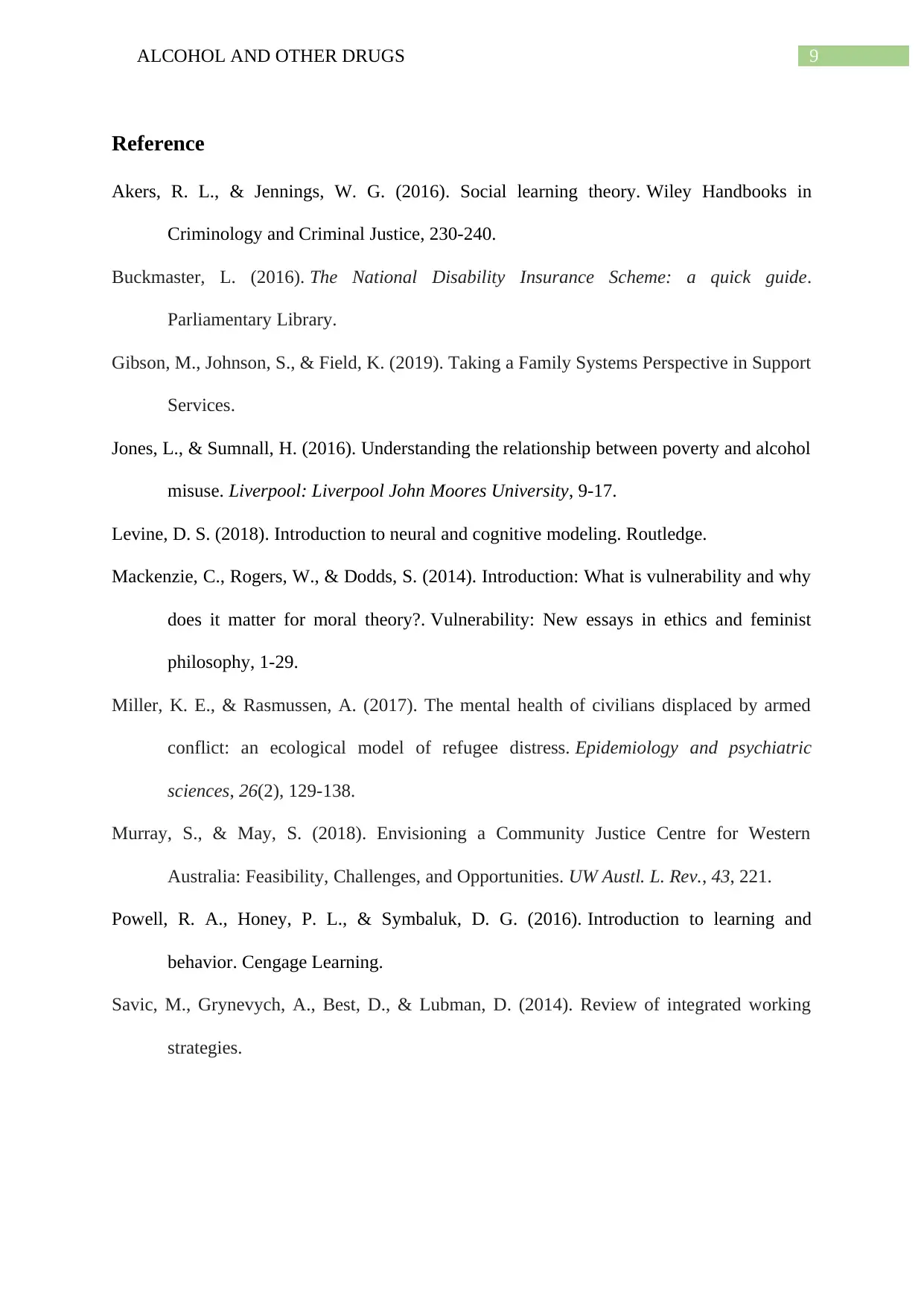
9ALCOHOL AND OTHER DRUGS
Reference
Akers, R. L., & Jennings, W. G. (2016). Social learning theory. Wiley Handbooks in
Criminology and Criminal Justice, 230-240.
Buckmaster, L. (2016). The National Disability Insurance Scheme: a quick guide.
Parliamentary Library.
Gibson, M., Johnson, S., & Field, K. (2019). Taking a Family Systems Perspective in Support
Services.
Jones, L., & Sumnall, H. (2016). Understanding the relationship between poverty and alcohol
misuse. Liverpool: Liverpool John Moores University, 9-17.
Levine, D. S. (2018). Introduction to neural and cognitive modeling. Routledge.
Mackenzie, C., Rogers, W., & Dodds, S. (2014). Introduction: What is vulnerability and why
does it matter for moral theory?. Vulnerability: New essays in ethics and feminist
philosophy, 1-29.
Miller, K. E., & Rasmussen, A. (2017). The mental health of civilians displaced by armed
conflict: an ecological model of refugee distress. Epidemiology and psychiatric
sciences, 26(2), 129-138.
Murray, S., & May, S. (2018). Envisioning a Community Justice Centre for Western
Australia: Feasibility, Challenges, and Opportunities. UW Austl. L. Rev., 43, 221.
Powell, R. A., Honey, P. L., & Symbaluk, D. G. (2016). Introduction to learning and
behavior. Cengage Learning.
Savic, M., Grynevych, A., Best, D., & Lubman, D. (2014). Review of integrated working
strategies.
Reference
Akers, R. L., & Jennings, W. G. (2016). Social learning theory. Wiley Handbooks in
Criminology and Criminal Justice, 230-240.
Buckmaster, L. (2016). The National Disability Insurance Scheme: a quick guide.
Parliamentary Library.
Gibson, M., Johnson, S., & Field, K. (2019). Taking a Family Systems Perspective in Support
Services.
Jones, L., & Sumnall, H. (2016). Understanding the relationship between poverty and alcohol
misuse. Liverpool: Liverpool John Moores University, 9-17.
Levine, D. S. (2018). Introduction to neural and cognitive modeling. Routledge.
Mackenzie, C., Rogers, W., & Dodds, S. (2014). Introduction: What is vulnerability and why
does it matter for moral theory?. Vulnerability: New essays in ethics and feminist
philosophy, 1-29.
Miller, K. E., & Rasmussen, A. (2017). The mental health of civilians displaced by armed
conflict: an ecological model of refugee distress. Epidemiology and psychiatric
sciences, 26(2), 129-138.
Murray, S., & May, S. (2018). Envisioning a Community Justice Centre for Western
Australia: Feasibility, Challenges, and Opportunities. UW Austl. L. Rev., 43, 221.
Powell, R. A., Honey, P. L., & Symbaluk, D. G. (2016). Introduction to learning and
behavior. Cengage Learning.
Savic, M., Grynevych, A., Best, D., & Lubman, D. (2014). Review of integrated working
strategies.
1 out of 10
Related Documents
Your All-in-One AI-Powered Toolkit for Academic Success.
+13062052269
info@desklib.com
Available 24*7 on WhatsApp / Email
![[object Object]](/_next/static/media/star-bottom.7253800d.svg)
Unlock your academic potential
Copyright © 2020–2025 A2Z Services. All Rights Reserved. Developed and managed by ZUCOL.





